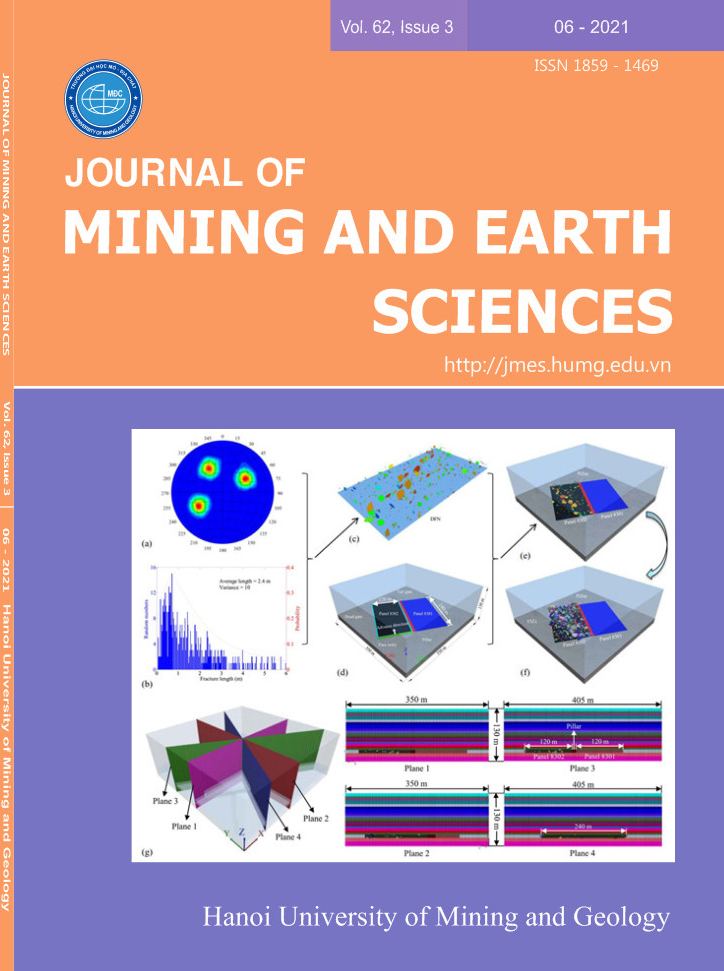Study of the micro-crack growth in the concrete material to predict its lifetime
Tóm tắt
The concrete always contains microstructures like micro-crack, voids, etc. These parameters affected the lifetime of materials. This article presents a computation algorithm to predict the lifetime of brittle materials like concrete which depends on the distribution of micro-crack in the materials. The proposed model is based on subcritical crack growth using the linear elastic fracture mechanics (LEFM) approach. The algorithm considers both tensile and shear fracturing. The proposed model was applied to a concrete sample under compressive loading for the prediction of a lifetime. The results showed a significant difference in failure zones and failure time under different magnitude compressive loadings and initial crack length.Tài liệu tham khảo
Barenblatt, G.I., (1962). The mathematical theory of equilibrium cracks in brittle fracture. Advances in Applied Mechanics 7(1), 55-129.
Bažant Z.P., (1984). Size effect in blunt fracture: Concrete, rock, metal. Journal of Engineering Mechanics 110(4), 518-535.
Bažant Z.P., Oh B.H., (1983). Crack band theory for fracture of concrete. Materials and Constructions 16, 155-177.
Bažant Z.P., Kim J.K., Pfeiffer P.A, (1986). Determination of fracture properties from size effect tests. Journal of Structural Engineering ASCE 112(2), 289-307.
Caruso H., Dasgupta A. (1998). A fundamental overview of accelerated testing analytical models J. IEST 41, 16-20.
Charles R.J.,(1958). Static fatigue of glass. Journal of Applied Physics 29, 1549-1560.
Dugdale D.S.,(1960). Yielding of steel sheets containing slits. Journal of Mechanics and Physics of Solids 8(2), 100-104.
Eyring H., (1936). Viscosity, plasticity, and diffusion as examples of absolute reaction rates. Journal of Chemical Physics 4, 283-291.
Itasca Consulting Group (2019). FLAC manual. Minneapolis, Minnesota USA.
Guedes R.M.,(2006). Lifetime prediction of polymer matrix composites under constant or monotonic load. Composites Part A 37, 703-715.
Hillerborg A., Modeer M., Petersson P.E., (1976). Analysis of crack formation and crack growth in concrete by means of fracture mechanics and finite elements. Cement and Concrete Research 6, 773-782.
https://en.wikipedia.org/wiki/Fracture_toughness
Irwin G.R.,(1957). Analysis of stresses and strains near the end of a crack traversing a plate. Journal of Applied Mechanics, Transactions ASME 24, 361-364.
Jenq Y.S., Shah S.P., (1985). Two parameter fracture model for concrete. Journal of Engineering Mechanics ASCE 111(10), 1227-1241.
Konietzky H., Heftenberger A., Feige M., (2009). Life-time prediction for rocks under static compressive and tensile loads: a new simulation approach. Acta Geotechnica 4, 73-78.
Nallathambi P., Karihaloo B.L.,(1986). Determination of specimen-size independent fracture toughness of plain concrete. Magazine of Concrete Research 38, 67-76.
Sulzer A.I., (1976). Der Zerstörungsvorgang in Festkörpern. In: Balarin M (ed) Festkörperphysik - Entwicklungstendenzen und Anwendungsmöglichkeiten. Akademie-Verlag, Berlin, 224-247.
Xu S., Reinhardt H.W., (1998). Crack extension resistance and fracture properties of quasi-brittle materials like concrete based on the complete process of fracture. International Journal of Fracture 92, 71-99.
Xu S., Reinhardt H.W., (1999). Determination of Double-K criterion for crack propagation in quasi-brittle materials, part I: Experimental investigation of crack propagation. International Journal of Fracture 98, 111-149.
Xu S., Zhang X., (2008). Determination of fracture parameters for crack propagation in concrete using an energy approach. Engineering Fracture Mechanics 75, 4292-4308.


